|
|
|
Mart Laar “Britain and the Estonian War of Independence” Tallinn, 1998 (Vincent/Uniprint).
© M.Laar
OCR & spellcheck (2004): Ilja Vasiljev (ilja_2003@mail.ru)
Eesti Vabariigi
80. aastapäev
80th Annivesary
of the Republic of Estonia
Eesti Vabadussõda
ja Suurbritannia
1918
1920
Britain and
The Estonian War
Of Independence
The British Embassy in Tallinn
would like to thank Mart Laar
for his help in preparing this brief overview
of Britain's involvment
in the Estonian War of Independence.
The life of Estonians has been anything but easy. A favourable location on the crossroads between east and west, and between north and south, not only brought wealth, but also turned Estonia into a battleground in bloody wars. But Estonians, whose quest for freedom was never crushed by foreign invaders and rulers, retained the limestone coast of the Baltic Sea as their home.
Seizing their opportunity for self-determination Estonia declared itself independent on February 24, 1918, when the Russian empire collapsed in World War I. Estonia was then occupied by the Germans while the Bolsheviks stood by, ready to move in after the Germans had left. Estonians had no other option but to defend their newly-found freedom with arms.
In these times only a few countries in the world had faith in the independence of the Baltic states or saw their significance for Europe. Estonian delegations abroad, formed in the winter of 1918, faced a difficult task. They had to seek international recognition for a young republic and obtain aid to safeguard independence.
Estonia's diplomats pinned high hopes on Britain. For Estonia, squeezed between Germany and Russia, it was natural to consider Britain a stronghold and defender of democracy. On February 4, 1918 in Stockholm in a petition submitted to the Entente countries, Estonia sought recognition for its struggle for independence. On March 20, 1918 the British government announced that it was prepared to acknowledge provisionally the Estonian State Council in the period up to the Peace Congress. The Estonians, who also
1
appealed to the embassies of the Entente countries in Petrograd, found a staunch supporter for their cause in F. O. Lindley, counselior in the British Embassy.
When the Estonian delegation arrived in London on April 9, 1918 they were met by Professor J. Y. Simpson who was in charge of Baltic affairs and a supporter of the activities of the Baltic nations.
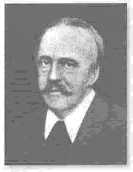
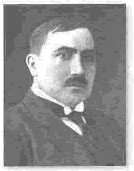
British Foreign Secretary A.J. Balfour // Representative of the Estonian Provisional Government A.Piip
On April 23, 1918 the representatives of Estonia - A. Piip, K.R. Pusta and E. Virgo - met in London with Mr. Balfour, British Foreign Secretary. In a reply to the Estonian petition issued on May 3, 1918, Her Majesty's Government said "it cordially welcomes the endeavours of the Estonian people and is pleased to re-assure its readiness to recognise the Estonian State Council as a de facto independent institution until the peace congress is convened." A. Piip was recognised as an "informal diplomatic representative" of the provisional government of Estonia. Britain was also one of the first countries to develop trade relations with independent Estonia. Estonia raised Ј150,790 by selling to the British linen and timber that had been confiscated from Bolshevik cargo vessels.
However, it would be wrong to say that Estonia's efforts were met with enthusiasm in Britain. The results achieved by
2
Estonians had more to do with successful lobbying of individual politicians than with Britain's official policy.
Since Britain had no declared interests in the Baltic Sea, its policy towards the independence drive of the Baltic nations lacked coherence. When the Russian revolution started, the British believed that the Baltic nations should remain in the Russian Federation. However, when the Bolsheviks in Russia seized power and Germany's actions intensified, the British policy became more pro-active. Although Britain was not seeking to establish colonies or protectorates on the coast of the Baltic, it did not want to see the Baltic becoming a German sea or let the Bolsheviks move westward. Britain was keen to ensure the security of the Baltic and maintain control over the Danish Straits. Thus it had little option but to despatch its fleet to the Baltic.
In their representations and proposals, Estonia's first diplomats were successful in showing that both nations shared common interests and they helped to shape for Estonia the policies of this great power.
Meanwhile, tensions in the Baltic Sea region mounted. Germany had lost the war and was engulfed by a revolution. Chasing retreating German troops, the Red Army moved westwards across the Baltic states. National governments in Latvia and Lithuania were overthrown as the Red Army rapidly moved towards Eastern Prussia. In Estonia, the Bolshevik Army progressed quickly and soon was only 20 miles from the capital of Estonia. The fact that the sea was controlled by the Red Fleet further affected Estonia's position.
In these circumstances the need for foreign aid became a matter of urgency for Estonia. In its repeated appears to western countries, Estonia asked Britain to send its fleet to Estonian waters, to land its troops and provide Estonia with weapons and food. Negotiations over the fleet's movements were held by A. Larka, the
3
Minister for War, and Estonian diplomats. In the final talks held in London on November 20, 1918 Estonia was represented by A. Piip, M. Martna and E. Virgo with Foreign Secretary Lord Robert Cecil and Vice-Admiral Sir S. R. Fremantle, Assistant Naval Commander, representing Great Britain. The British announced that they had decided to aid Estonia on condition that "the Government of Estonia is stable, determined and based on democratic principles in its fight against Bolsheviks and disorder". Since the despatch of troops to Estonia was considered impossible, aid was provided through other means.
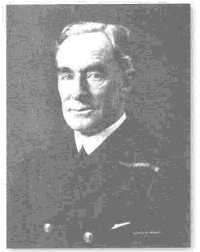
Rear-Admiral Sir E.A. Sinclair
On November 27, 1918 a British fleet consisting of 5 light cruisers, 9 destroyers, 1 transport vessel, several minesweepers and torpedo-boats set out for Estonia under Rear-Admiral Sir Edwin Alexander Sinclair. On December 1, 1918 it arrived in Liepaja. On December 6, Cassandra, the British light cruiser, hit a mine near Hiiumaa and sank.
The squadron of British battleships returned to Copenhagen to wait for new orders. At the same time the Estonian government intensified its plea to send the fleet to Tallinn. During a meeting with Admiral Sir S. R. Fremantle, A. Piip expressed his hope that "Britain as a great power would not change its policy because of one cruiser".
On December 8 the British fleet returned to Liepaja. On the same day Colonel
4
J. Laidoner, the freshly-nominated Estonian Commander-in-Chief, and pilots arrived in Liepaja to convince Sir Sinclair to set out for Tallinn. After approval from London, the British fleet left for Tallinn on the evening of December 11.
Three British light cruisers, nine destroyers and "Princess Margaret" carrying ammunition arrived in Tallinn on December 12 at 3 p.m. According to Piip, this aid came on time unlike in 1343 when Estonian forces were defeated by Teutonic Knights when the Swedish fleet was a few days late.
Most historians agree that the arrival of the British fleet achieved a breakthrough in the Estonian War of Independence. Later, General J. Laidoner said: "I am sure that without the arrival of the British fleet in Tallinn in December 1918, the fate of our country and our people would have been very different -Estonia and, I believe, other Baltic states would have found themselves in the hands of the Bolsheviks."
However, the arrival of the British fleet also raised unreasonable hopes. It was believed
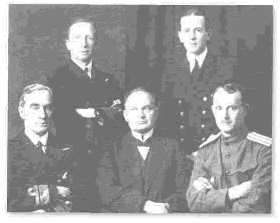
Estonian Prime Minister K.Pärts (center) & Chief of the General Staff J.Laidoner (right to ground) with British senior naval officers & the Estonian communications officer (back right)
5
that the British occupation forces would soon arrive in Estonia to take over the main burden in the fight against the Bolsheviks. On December 27 the Land Council decided to appeal to Britain to occupy Estonia. This, however, was contrary to British interests and capabilities. Britain wanted to see Estonia itself deal with its problem, or as a local newspaper put it: "The British request a stable, which means a steady and dependable, government to fight disorder and the Bolsheviks. No-one else will do it for us - we have to set up such a government ourselves. It is we who must pass the test."
Estonia became increasingly ready to take that test. Although the arrival of the British fleet in Tallinn came as a nasty surprise for local Bolsheviks, they attempted to organise an uprising in Tallinn. A demonstration, held on December 17 under the slogan "Go home British" and attended mainly by Russian workers from large factories, was dispersed. The influence of the Bolsheviks in Estonia began to crumble.
On December 24, 1918 the commanders of the
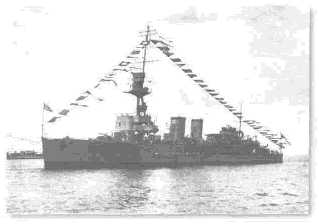
British command vessel
6
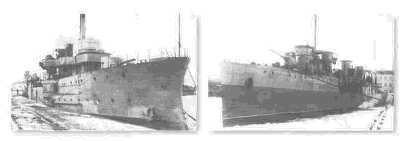
The first Estonian warship Lembit. The Estonian minevessel Vambola.
Russian Baltic Fleet ordered a military operation on Tallinn Bay. However, the operation and the formation fell apart.
On December 26 the mine cruiser Spartak arrived in Tallinn Bay. After a warning from the monitoring station, five British destroyers attacked the Russian ship. Although Spartak tried to escape, gunfire had destroyed the cruiser's navigation instruments and it ran aground at the Kuradimuna shallow and surrendered. On December 27 two British light cruisers and three destroyers forced Avtroil, a Russian mine cruiser, to surrender near Korgessaare and gave the captured vessels over to the Estonian fleet. This changed the balance of power in the Baltic. Although from then on the British fleet was less involved in direct military activities, its presence ensured the operational freedom of the Estonian fleet.
Vitally important for the Estonian people's army, the British Navy also supplied them with modern weaponry. During a few weeks starting on December 12, the British shipped to Estonia light machineguns and ammunition. This consignment was made up of 100 Lewis and 107 Madsen machineguns and 6,500 Russian rifles with ammunition. New weapons raised the Estonians' morale and sowed the seeds of panic among the enemy. Since the Russians had never seen a
7
light machinegun, they believed the Estonians had a pistol that could be used like a machinegun.
However, the fighting spirit and the will of the Estonian army had an even more crucial impact on the situation. The Estonians launched a counterattack against the Red Army at the beginning of January 1919, and, before the enemy recovered from the surprise, Estonian territory was liberated. The Bolsheviks had to halt their attack to the West and sent to South Estonia Red Latvian riflemen, who were also defeated.
Also significant was the success of the Estonian defence force at the international level, since it helped to make Estonia known in Europe. According to the British Foreign Office, "of all states and governments that emerged during the World War, the Estonian state and government have been most stable". It helped to ensure that the British continued and even increased their aid to Estonia.
By the end of February 1919 the Estonian defence forces received from Great Britain 20 cannons, approximately 700 machine-guns, 26,500 rifles, 31,000 cannon shells and 30.5 million bullets in addition to vehicles, telephones and other equipment. The British also sent to Estonia experts and advisers in those fields where Estonians lacked the necessary expertise. In addition to military aid, Estonia received from Great Britain coal, oil and petrol that were vital in the field of transport and energy. Early 1919, when Estonia faced hunger, 550 tons of wheat arrived from Great Britain on February 9, 1919. That again helped Estonia to avoid the worst.
Although Western countries were still reluctant to recognise the independence of Estonia, Latvia and Lithuania de jure, they became ever more sceptical towards "a joint and indivisible Russia". Although the Russian white guards made repeated requests to put
8
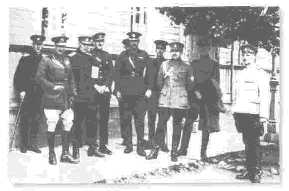
Lientenant General Sir H.Gough (second from the left).
Estonian forces under their command, the Allies opposed the plan. In order to coordinate the fight against Bolshevism, the Entente powers sent a military mission to the Baltic states headed by Lieutenant General Sir Hubert Gough. On June 23, 1919 the British military delegation, consisting of 24 officers, arrived in Estonia.
Sir Gough gave his support to the Estonian struggle for independence and asked the British government to recognise the Republic of Estonia de jure. The British Government also warned the Estonians about the cooperation between the Baltic-German Landeswehr army and the Russian white guards. Although the fleet headed by Sir Sinclair was replaced by Rear-Admiral Walter Cowan, there were no changes in British policy.
Military operations continued. The Red Army made yet another attempt to invade Estonia, but was defeated. In the spring of 1919, the Soviet Baltic Fleet tried repeatedly to break through the mine barriers that closed the eastern part of the Finnish Bay.
On May 18, 1919 the armoured battleship Andrei Pervozvannoi, four minesweepers, the destroyer Gavriil and two guard-ships tried to enter Kaporje Bay. The attempt was thwarted by four British destroyers. On May 29, 1919 a similar effort was broken up by a British submarine and seaplanes. On June 4, 1919 two Russian destroyers, Azard and
9
Gavriil, broke into Kaporje Bay when they were attacked by a British submarine L 55. The attack failed The submarine was hit by a destroyer. It submerged, hit a mine and sank with the whole crew.
Military activities on the Baltic Sea intensified m the summer of 1919. The Soviet Baltic Fleet put out to sea from Kronstadt. On the night of June 17 CMB-4, a torpedo boat based at Terijoki on the Finnish coast and under the command of Captain Lieutenant A. W. S. Agar, engaged Oleg, the only cruiser of the Soviet Fleet that was able to fight. 400 metres from the cruiser, Agar launched a torpedo and then quickly retreated. The torpedo hit Oleg's left boiler-room and the cruiser capsized in 12 minutes. Most of the Russian crew was rescued.
Enthusiastic about success, the British brought more torpedo boats and seaplanes to the Baltic. They started to prepare a surprise attack on Kronstadt where the Russian Baltic fleet had its base. During the night of August 18, 1919 eight torpedo boats left their bases in Finland. At 1.30 when the boats were approaching Kronstadt, twelve seaplanes made a surprise attack on the port. The Russians sounded the alarm and the ships opened fire on the planes. The Russians, busy fighting against the aerial attack, failed to notice the torpedo boats entering the port. CMB 79 led by Lieutenant Bremner sank cruiser Pamjat Azova, the submarines' base. CMB 31 under the command of Captain-Lieutenant Dobson and CMB 88 led by Lieutenant Dayrell-Reed torpedoed the armoured ship Andrei Pervozvannoi and battleship Petropavlovsk. When the torpedoes launched at the destroyer Gavriil missed, Gavriil managed to sink two torpedo boats. During the exit from the port a third boat was damaged and blew up. In spite of losing three vessels, the British considered the surprise attack at Kronstadt an overwhelming success.
10
The British fleet carried other losses, too. On July 6, 1919 HMS Vindective ran aground in Tallinn Bay and, although the equipment intended for the Estonian army was unloaded, the vessel returned to Great Britain for repairs. A week later two British minesweepers, HMS Gentlan and HMS Myrtle, hit mines near Hiiumaa. On August 31 eight British sailors drowned when HMS Victoria, a British destroyer, was sunk near Seskari islands by the Russian submarine, Pantera. On September 4 HMS Verulam, a British destroyer, hit a mine near the Finnish coast at the Stirsuddien lighthouse and sank with 29 men aboard.
To reinforce its operations, Britain asked the Estonian government on September 8, 1919 for permission to transform Naissaar into a base for the British fleet. Permission was granted on September 9. In the autumn of 1919 the British and Estonian fleet participated in the Krasnaja Gorka operation, attacking opposing forces with heavy gunfire.
The Red Fleet attempted to restrict the movement of the British and Estonians by laying mine barriers, but during the night of October 21, 1919 hit its own mines and lost three destroyers. Soon the British fleet was reinforced by Erebus, a monitor. Although Erebus attempted during the following days to quash the heavy artillery of Krasnaja Gorka, little was achieved.
It soon became clear that the Russian white guards were unable to take Petrograd. Their Northwestern Army was destroyed in a counterattack by the Red Army. The front quickly reached Estonian borders where the Estonian People's Army stopped the Red Army's progress. In heavy fighting the Estonian Army succeeded in maintaing its positions. Although at first the British were strongly against the Estonians' plan to sign a peace treaty with Soviet Russia, they changed their position when the Russian white guards were defeated. As a result of peace talks which began in Tartu the fighting ended on January 3,
11
1920. The Peace Treaty was signed in Tartu on February 2,1920. Under the terms of the Treaty Russia unconditionally acknowledged Estonia's independence.
Estonia had achieved its most important historic victory. The British were among those who gave their lives in the fight for Estonia's freedom in the Baltics in 1918-1919. The losses of the British fleet in the Estonian War of Independence amounted to one light cruiser, two destroyers, one submarine, two sweepers and eight torpedo boats. The presence of the British fleet and its operations eliminated the Soviet Baltic Fleet and, moreover, assured young democracies that they were not alone in their fight.
And this is something that we should not forget.
Mart Laar